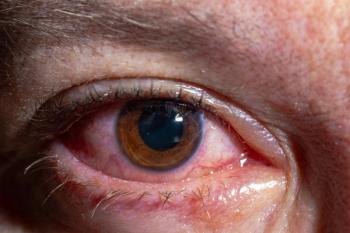
Izervay Continued to Show Benefit in Geographic Atrophy in Open-Label Study
Key Takeaways
- Early intervention with Izervay results in greater protection of retinal tissue and reduced lesion growth in geographic atrophy patients.
- The GATHER2 study extension shows a 40.5% reduction in lesion growth for treated patients over 3.5 years.
Lesion growth was reduced by 40.5% in patients receiving Izervay in an open-label study. A real-world study confirms safety in more than 10,000 patients.
Earlier intervention with Izervay (avacincaptad pegol) to treat patients with geographic atrophy (GA) results in greater protection of retinal tissue area, according to first reports from an open-label extension study, which was presented at the American Academy of Ophthalmology 2025 Annual Meeting (AAO 2025).
In the 18-month open-label extension of the phase 3 GATHER2 study, Izervay continued to reduce geographic atrophy lesion growth for up to 3.5 years.
“Izervay maintains a consistent safety profile and is associated with meaningful reduction in disease progression over time, with the most pronounced benefits observed in patients who initiated treatment at an earlier stage,” Arshad M. Khanani, M.D., MA, director of clinical research at Sierra Eye Associates and clinical professor at University of Nevada, Reno, Nevada, said in a news release.
Patients in the open-label extension who had previously completed the GATHER2 study switched to Izervay monthly regardless of whether they had a sham treatment or had received the therapy monthly or every-other-month. The open-label portion assessed disease progression, as measured by mean change in lesion growth.
Lesion growth was reduced by 40.5% from month 24 to 3.5 years compared with the projected sham in patients who had received treatment in the clinical study. In patients who had switched to Izervay after receiving sham treatment, lesion growth was reduced by 37%.
Izervay was well-tolerated with no new safety signals, no cases of retinal vasculitis or occlusive vasculitis, and no increased risk of intraocular inflammation.
A separate real-world study of 10,181 patients and 13,391 eyes in patients with geographic atrophy assessed Izervay in the first year after its approved by the FDA in August 2023. This observational analysis was based on data from the IRIS Registry (Intelligent Research In Sight) found no new safety signals and low rates of discontinuation. IRIS is a large eye disease clinical registry developed by the American Academy of Ophthalmology. It contains data on more than 788 million patient visits from more than 15,000 ophthalmologists.
Geographic atrophy is a progressive, advanced form of age-related macular degeneration, characterized by the development of lesions on the macula, which is the part of the retina responsible for detailed central vision. It affects about 1.5 million people in the United States and can lead to permanent vision loss.
Izervay was developed by Iveric Bio, which was
In February 2025, Izervay had been approved for use longer than 12 months. Previously, it was approved for use for only 12 months.
Izervay has a
Newsletter
Get the latest industry news, event updates, and more from Managed healthcare Executive.

















































